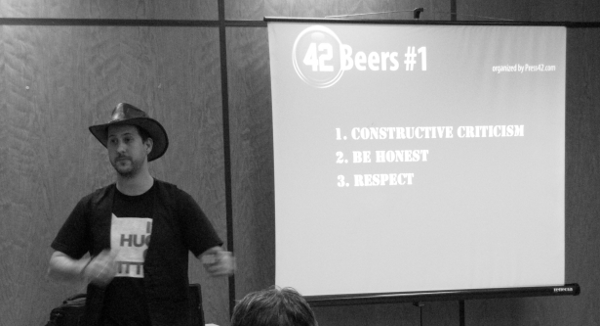9 tips to deliver better pitches

Last week we did our first physical event, called 42 beers. I was a little bit nervous about it as it was the first time we where doing it and the concept is a little vague for most startups. Many of the startup pitching events I normally attend are mainly focused on the business idea part of the pitch. It’s interesting because one of the attendees of the event asked the following question: are we giving feedback on the business idea or the communication skills? It was a very good question because the main difference between this event and other pitching slams is that we want it to be focused on the communication side of the presentation. It’s not that we don’t value the business side, which I personally do, but more the fact that the communication side of it is always forgotten and it’s, in our opinion, the reason why a pitch hits it’s mark.
I must confess I was delighted (and others too) with the quality of the feedback. We got investors, startup guys and journalists in the room and each one gave a very different opinion. This was fascinating because it showed everyone how heterogeneous your crowd can be and how you have to be prepared for it. After the event I discussed with my wife if there was such thing as the perfect pitch presentation that satisfies everyone. Granted that each interested party had different in depth questions, but I truly believe you can deliver a presentation so clear that everyone can understand it. In most cases, the questions that you get asked can be narrowed to around 15 different questions. That means, you could potentially prepare an extra slide for each of them. As always, research and knowledge of your domain are paramount.
The following are some of the key lessons we extracted from the first edition of 42 beers. Feel free to add your own on the comments:
1. Your presentation shouldn’t sound rehearsed, even if it is. The audience can always detect a phony. That means, you should keep working on your presentation every time you give it. Change the pictures, change your story names, add jokes, remove slides, etc. each time you deliver your pitch it should sound new and fresh. The audience will slam you if they’ve seen you before and they recognize the same deck. People will mark you as lazy and you don’t want that.
2. When using numbers in your presentation, make sure you give a reference framework, that is, something to compare it with and know if it’s big or small. This was a suggestion by one of the journalist in the room. I personally thought it was a fantastic tip because it’s very usual to forget that the press has no idea how big or small your numbers should be. Things like, we have 3 times more users than or competitors, we have 10 times more viewers than the local newspaper, etc.
3. Less is more. When doing a quick presentation don’t try to fit what you said in a longer presentation. That will only ensure you’ll speak terribly fast and people won’t be able to follow. Each concept you throw to the audience requires some time to process. If you give too many concepts, you’ll loose them, no matter how good you explain it or how trivial it is. Remember, choose the essential topics and stick to them. As a rule of thumb, if you think you’ll have time to talk about all you want within the given time, it means you won’t make it. You need to end up with a presentation that you feel is going to take way less time than you actually have.
4. Stick to one problem-solution. Many startups are trying to fix several problems at the same time. This is just what lean and agile tells you not to do, but it’s hard to focus on just one thing, especially if you are an engineer. Nevertheless, when doing a quick pitch you need to forget all about that and focus on the single most important problem you’re trying to solve. If you add more than one, you give the audience mixed signals and they won’t have a clear idea how to compare you with others. You want them to remember you and for that, they need to store your startup info next to similar examples. The more complex you make that association linkage, the worst they’ll remember you.
5. Avoid technical words. If you need to use technical terms you’re probably doing it wrong. The more you use, the smaller your audience and while in some environments you can pull it of, your next audience won’t be so easy. The funny thing is that a talk without technicalities works everywhere while the other way around only works when surrounded by geeks.
6. Don’t assume everyone in the room shares your definition of a specific term. Always make sure everyone is on the same page. The easiest way to accomplish this is by defining what you understand by a specific term. You’ll have people that won’t agree with your definition but at least they’ll know what you are talking about. The problem is that we tend to use concepts that mean very different things to different people, for example the word “innovation” or the word “social” have a wide range of interpretations. Help the audience and define them so they don’t get confused.
7. Garner the power of slides. People use slides for a reason, they’re very good resources for story telling. They put the image to a narration, just like in a movie. Havoc arises when they’re used for other things. Slides aren’t meant to be replicas of the script, though many times startups pack specific slides with text. Other times they sin of quite the opposite, such minimalism that the slide is useless. A deck is your movie photography, if you don’t use it, you better go and write a novel.
8. Use slides to indirectly answer the audience questions. As said before, depending on your time constrains, you can’t possible answer all possible questions the audience has. Nevertheless you can be intelligent with your slides and use pauses and Q&A slides to showcase specific information. For example, one of the questions the tech audience had for both startups was, which mobile platforms were they available on. The discussion ended with a suggestion of employing the last slide with the call to action as a platform display where you could showcase the icons of all the platforms used. There is no need to explain it and the tech audience can easily decipher it without much problem.
9. Break the rules of classical story telling. The archetypal story uses a classical lineal timeline. It’s consistent with expectations and focuses on the main character. Sometimes is interesting to alter these rules to break the boredom. This is specially important if your startup is part of a large batch of presentations or if you present at the end of the day. Things like interwinding characters or stories or the use of anachronism works like a charm. Break the lineal timeline with unexpected events that take the audience off balance.
These are just some of the tips we saw during this first event. All in all I’m very proud of the feedback and we’ll keep track of all of the tips on a big document for future reference. Stay tuned for the next event and make sure you come with an open mind an constructive criticism.
See yah on the next event and let’s keep rocking the audience!!


















